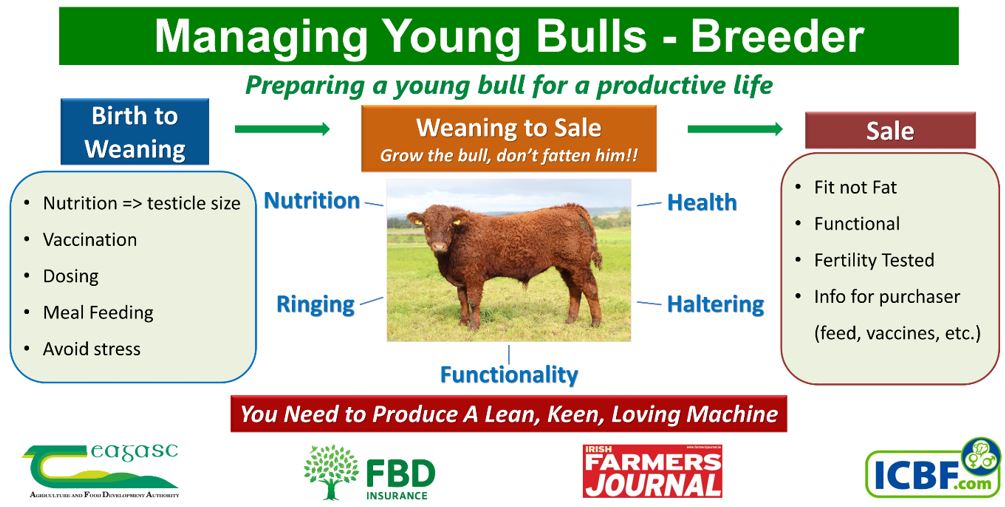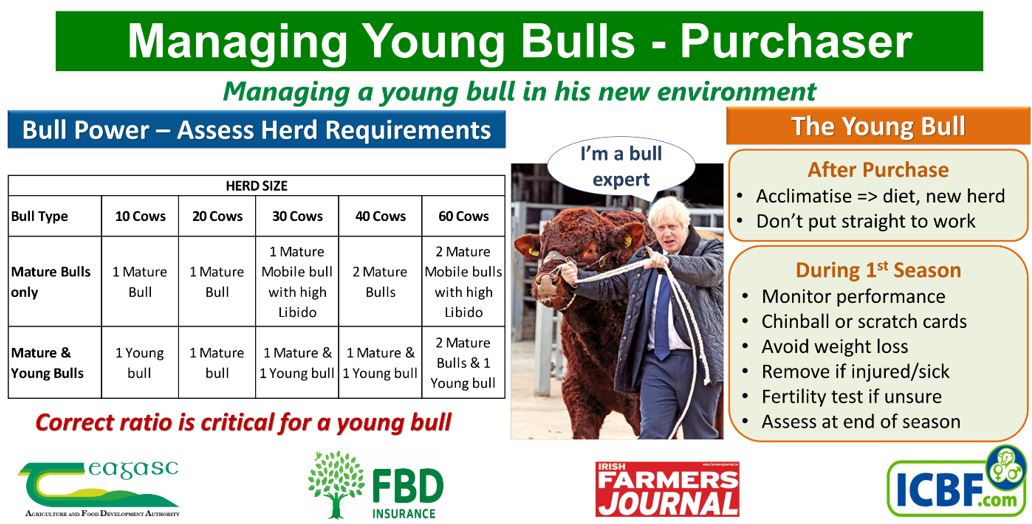At the recent farm walk for the winners of the “FBD Eurostar €200 Replacement Index Competition” at Joe and Richard Fortunes, Wexford, Doreen Corridan from Munster Bovine and Aidan Murray from Teagasc spoke about the importance of Stockbull management to have a successful breeding season.
The first part of their talk looked at young bull management form the bull breeder’s perspective. The importance of selling your bulls as ‘Fit’ rather than ‘Fat’ was emphasized. It was also acknowledged however that there needs to be a change in buyers’ attitudes for this to be a reality. Doreen and Aidan both mentioned that for a bull to attract the eye of a potential buyer at shows/sales he often needs to be pushed to stand out. This then perpetuates the problem with bull buyers selecting bulls who are not necessarily in ‘fit’ condition ready to work.
Other points elaborated on were bull calf management pre and post weaning. Ensure the bull is growing at a sufficient rate prior to weaning. This will also influence the growth of that bulls testicles which has a high correlation to sperm count which in turn influences cow conception rate. At weaning ensure to minimize stress, vaccinate and dose (before weaning) and meal feed to have the smoothest transition from on the cow to weaned.
The second part of the talk looked at managing a bull from the bull buyer perspective. Buying the bull at least 2 months in advance of the breeding season was recommended to allow sufficient time for the bull to acclimatize to the new surroundings, become nutritionally stable (transition from a concentrate to predominantly forage based diet), to be vaccinated for whatever is in the herd health program and time to learn how to serve cows. Purchasing a bull that is halter trained makes handling the bull much easier.
It is important that a young bull prior to the breeding season, is kept on a rising plane of nutrition. Weight/body condition loss can result in sub optimal fertility. Limit weight loss for the bull to a maximum of 50-100 kgs by feeding him during his first breeding season. Create conditions for the bull to exercise as opposed to being housed inside prior to the breeding season. Overfat bulls fatigue rapidly therefore nutrition and exercise need to be managed. Rumen function is also key for hoof health and sperm production. Care needs to be taken to prevent acidosis and laminitis developing.
Purchasing a bull from a herd with a high health status or johnes monitored and BVD tested is recommended. Otherwise vaccinate at least 3 weeks prior to the breeding season. A vaccinated bull is the best mitigation strategy you can adopt to reduce the probability of a bull suffering any infections or raised temperatures which could render him sub fertile. Having your purchased bull certified ‘fit’ by a vet is assurance that on that day he was healthy, had reached puberty and was producing semen capable of impregnating cows. This involves a veterinary exam for health, major physical defects and morphological examination of the semen.
Another mitigation strategy against an underperforming bull is to observe a bull serving a smaller cow or heifer prior to being let off with the rest of the herd. It is crucial to ensure your bull is capable, to be observed mating competently. If at any time the bull becomes lame, runs a temperature or develops photosensitization, it is recommended to remove him from the herd and when he has recovered get him fertility tested to ensure the semen quality has not been affected.
If you are looking to purchase a bull, go to the Stock Bull Finder; This is the ICBF online sales section for bulls from WHPR herds, who have been linear scored and or weighed by an ICBF scorer.


